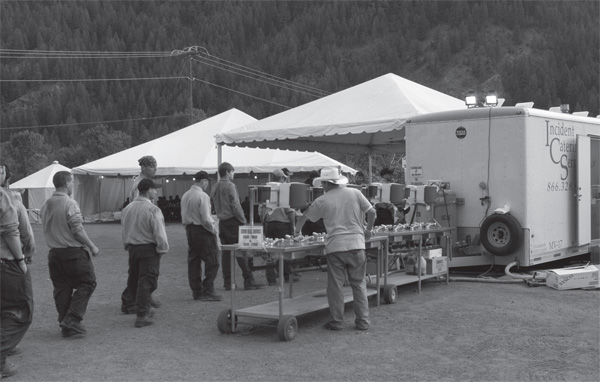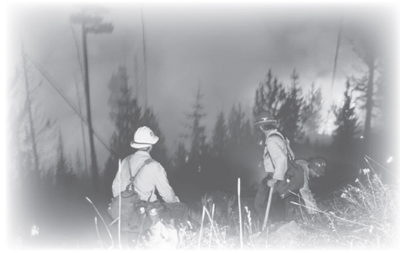Chapter 10—Nutrition and Performance

"An army marches on its stomach."
Napoleon Bonaparte
Recent research has identified nutritional strategies that will improve the health, safety, and performance of wildland firefighters. The right food sources, properly timed, provide energy and nutrients that help sustain work and maintain the immune system. Supplemental high-energy foods delay fatigue and enhance immune function while helping firefighters maintain their ability to think and make decisions during periods of hard work.
To ensure their health and performance, firefighters need to eat like endurance athletes. Firefighters require twice as many calories as normal—or more— when they are working on the fireline. This chapter is for wildland firefighters, incident management team members, support personnel, and those interested in good nutrition for health and performance. The chapter includes information on energy and nutrient needs, the timing of food intake, vitamin and mineral supplements, and weight management. Intermittent feeding (shift food) maintains blood glucose, work output, immune function, mood, and the ability to make decisions throughout the work shift. We'll deal with hydration in chapter 11, "Environment and Performance."
Firefighting is a physically demanding occupation, with energy requirements as high as 6,000 kilocalories per day. Firefighters who do not consume enough calories will become fatigued and lose body weight and muscle. Consuming too few calories during a busy fire season can impair immune function and lead to illness.
Firefighters should check their weight every 2 weeks during the season. The best time is in the morning before breakfast (but after urination). The energy for work comes from carbohydrate, fat, and protein.
Carbohydrate
Carbohydrates are digested, converted to glucose, and stored in your liver and muscle as glycogen (branched chains of glucose molecules). Muscle glycogen fuels the muscles during work; liver glycogen maintains blood glucose, the primary fuel for the brain and nervous system. When blood glucose levels drop during extended physical activity, carbohydrates from the food we eat can provide blood glucose. If your diet does not include enough carbohydrate, the body will make blood glucose from muscle protein, a poor alternative because muscle is needed for the work at hand.
Long hours of strenuous fireline work increase a firefighter's daily carbohydrate requirements. Each gram of carbohydrate provides 4 kilocalories of energy (table 10.1). Carbohydrate needs are based on body weight (in kilograms) and work rate.
| Food | Grams (ounces) of carbohydrate |
Kilo- calories |
|---|---|---|
| 1 slice bread | 12 (0.42) | 48 |
| 1 cup beans | 48 (1.69) | 192 |
| 1 cup rice | 37 (1.30) | 148 |
| 1 cup corn | 41 (1.45) | 164 |
| 1 medium apple | 21 (0.74) | 84 |
| 1 energy bar | 27 (0.95) | 108 |
| 1 cup sports drink | 15 (0.53) | 60 |
| 1 cup milk | 12 (0.42) | 48 |
| 1 cup yogurt | 14 to 44 (0.49 to 1.55) | 56 to 176 |
Determine your weight in kilograms by
dividing your weight in pounds by 2.2.
For a 154-pound firefighter:
154 pounds/2.2 = 70 kilograms
Hard Work: 5 to 7 grams (0.18 to 0.25
ounces) of carbohydrate is required per
kilogram of body weight per day.
5 to 7 grams x 70 kilograms = 350 to
490 grams (12.35 to 17.3 ounces) of
carbohydrate required per day
Harder Work: 7 to 10 grams (0.25 to
0.35 ounces) of carbohydrate is required
per kilogram of body weight per day.
7 to 10 grams x 70 kilograms = 490 to
700 grams (17.3 to 25.7 ounces) of
carbohydrate required per day
For ultraendurance sports or very hard work, the carbohydrate requirement could be even higher.
Carbohydrate-rich foods include wholegrain products, beans, rice, corn, peas, potatoes, fruit, fruit juice, milk, yogurt, energy bars, and sports drinks. So-called energy drinks contain little carbohydrate.
During work, firefighters need 40 per day. grams (1.41 ounces) of carbohydrate each hour from snacks and sports drinks. An energy bar may contain 25 grams (0.88 ounces) of carbohydrate, and 1 cup of sports drink may contain 15 grams (0.53 ounces), for a total of 40 grams (1.41 ounces) of carbohydrate (40 grams x 4 kilocalories per gram = 160 kilocalories of energy). Field studies of firefighters show that carbohydrate energy supplements improve work output, immune function, blood glucose, and mood.
Shift Food
During prolonged endurance events, athletes eat throughout the event. Field studies of firefighters show that intermittent feeding throughout the shift maintains blood glucose and work output. Firefighters consuming shift food performed more work, especially during the last 4 hours of the shift, compared to firefighters who had a traditional sack lunch.
Fat
Fat should provide 20 to 35 percent of
daily calories with a minimum recommended
amount of 1 gram of fat per
kilogram (0.035 ounces per pound) of
body weight. No more than one-third of
the fat should come from saturated and
trans fats such as butter, lard, dairy fat,
and some processed fats—read the
labels. The balance of fat should come
from monounsaturated and polyunsaturated
fats (such as olive, canola, and
peanut oils or nuts such as almonds and
hazelnuts). If a firefighter needs 4,000
kilocalories per day when fighting fire,
one-quarter of those calories (1,000
kilocalories) can come from fat.
Because each gram of fat has about 9
kilocalories, 111 grams of fat would
provide about 1,000 kilocalories.
Firefighters doing light work (2,200
kilocalories) only need 56 grams of fat. Because each gram of fat has about 9 kilocalories, 111 grams of fat would
provide about 1,000 kilocalories.
Firefighters doing light work (2,200
kilocalories) only need 56 grams of fat per day.
Protein
Athletes and wildland firefighters
require 1.2 to 1.8 grams of protein per
kilogram of body weight (0.042 to
0.064 ounces per pound)—1.2 grams
for moderate work and 1.8 grams for
prolonged hard work under adverse
conditions and for recovery. For this
example, we will use a 154-pound
(70-kilogram) firefighter needing 1.5
grams of protein per kilogram (0.053
ounces per pound) of body weight:
70 kilograms x 1.5 grams = 105 grams
(3.7 ounces) of protein per day
Table 10.2 shows the amount of protein in some food choices.
| Food | Portion | Grams(ounces) of protein |
|---|---|---|
| Almonds | ¼ cup | 5 (0.18) |
| Beans | ½ cup cooked | 8 (0.28) |
| Beef | 4 ounces | 35 (1.23) |
| Cheese | 1 ounce | 7 (0.25) |
| Chicken | 4 ounces, no skin | 37 (1.30) |
| Chili | 1 cup | 20 (0.70) |
| Corn | ½ cup cooked | 3 (0.11) |
| Egg | 1 | 6 (0.21) |
| Fish | 4 ounces | 31 (1.09) |
| Hamburger patty | 4 ounces | 20 (0.70) |
| Milk | 1 cup | 8 (0.28) |
| Peanut butter | 1 tablespoon | 4 (0.14) |
| Pizza | 1 slice | 10 (0.35) |
| Pork | 4 ounces lean | 35 (1.23) |
| Rice | ½ cup cooked | 2.5 (0.09) |
| Sunflower seeds | ¼ cup | 8 (0.28) |
| Tofu | 1 cup | 6 to 9 (0.21 to 0.32) |
| Veggie burger | 4 ounces | 5 (0.18) |
Nutrients: Vitamins and Minerals
Nutrition needs: Determine your caloric and nutrient needs by using the Web site http://www.mypyramid.gov/. This site suggests daily caloric and micronutrient (mineral and vitamin) needs based on your age, gender, and level of physical activity. Remember, the protein and carbohydrate requirements underestimate the needs of wildland firefighters. Click on the food group for additional information. Table 10.3 shows daily food requirements for light and for arduous work.
| Food | Light work |
Arduous work |
|---|---|---|
| Daily requirements |
2,200 kilocalories |
4,400 kilocalories |
| Fruit | 4 servings (2 cups) | 12 servings (6 cups) |
| Vegetables | 4 to 5 servings (2 to 2 ½ cups) | 8 servings (4 cups) |
| Whole grains* | 6 servings | 12+ servings |
| Milk or yogurt | 1 to 2 cups | 5 cups |
| Meat, fish** | 6 ounces | 10 ounces |
| *Whole grains and enriched or whole-grain products. **Meat, fish, or meat substitute. |
||
Firefighters do not need vitamin and mineral supplements if their diets include a variety of nutrient-rich foods and beverages and provide enough energy to maintain body weight. For more information on vitamin and mineral needs, see "Wildland Firefighter Health and Safety Report: No. 9".
The following issues are related to energy, nutrition, and weight management.
Immune Function—Psychological stress, exhaustion, smoke exposure, sleep deprivation, and dehydration can degrade immune function. A well balanced diet with adequate calories, meat, shellfish, fruits, and vegetables enhances immunity. Research has demonstrated that adding carbohydrate energy supplements during work helps maintain the immune function of wildland firefighters.
Ergogenic Aids—Ergogenic aids are products that are thought by some to improve performance. Few have been proven effective, especially in a long season of arduous work. Some (ephedra) have caused death. Others (anabolic steroids) can harm the heart. Use good food choices and fitness training to meet performance goals. For information on ergogenic aids, consult a registered dietitian—not Internet sites.
Special Needs of Incident Management Team Members—Incident management team members do less arduous work than wildland firefighters. Dietary recommendations are based on the daily energy expenditure required to maintain the body mass index (BMI) in the normal range (19 to 25). Use the http://www.mypyramid.gov/ Web site to determine nutritional needs. Review the BMI chart (see figure 3.1).
Weight Management—When fire season is over, eat less because your energy needs will be lower. To lose weight during the off season:
- Increase physical activity.
- Decrease calorie intake by eating less sweets and fats.
- Decrease portions of all foods.
Weigh yourself every 2 weeks to monitor your progress.

Begin the fire season physically fit, with a sound nutritional base.

